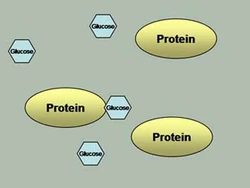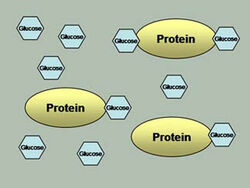
Good results-normal or well controlled diabetes; very little glycosylated proteins.
Fructosamine (frook-TOH-sah-meen) is a sugar-albumin complex that forms in chronic hyperglycemic conditions. A fructosamine test is a blood test that is used in animals to measure the average level of glucose control over the past few weeks. It's in proportion to the blood glucose concentration over the lifespan of the glycated protein being measured. The most common test for this in humans is the HbA1c, [1][2] which is very much like the Ghb or glycosylated hemoglobin test shown on this page. At present, HbA1c testing is not conducted for animals because there are no standardized measurements for the test. Lack of standardization means there are many possibilities for errors which would make the test a non-reliable source of information.[3]
Both tests [4] measure the level of glycosylated proteins in the blood. The higher the serum fructosamine concentration, the higher the blood glucose levels have been over the lifespan of the albumin protein, which is 1-2 weeks in dogs. [5] The serum fructosamine concentration is meant to reflect the blood glucose concentration level over a 7-10 day period prior to testing.
Fructosamine testing is favored for humans over HbA1c in cases where the age of red blood cells may be affected, such as blood loss or certain types of anemia, [6] where the test may not be reliable.
Serum fructosamine levels are significantly higher in untreated or poorly controlled diabetic pets compared with stressed or sick non-diabetic pets with hyperglycemia. [7]
Glycosylated hemoglobin tests[]
Glycosylated hemoglobin (Ghb) or (Hb) tests use insulin binding of glucose to the hemoglobin. In this way, it measures the average blood glucose for several weeks prior to testing. Ghb or Hb is similar to the HbA1c tests for human diabetics, because they both depend on the half-life of red blood cells.
Red blood cell life in dogs is 120 days; therefore a Ghb test will reflect average blood glucose concentration over an 8-12 week period. Half-life of red blood cells in cats is 66-78 days, so a Ghb test done on a cat reflects average blood glucose concentration over the 5-6 week period before testing. [8] Glycosylated hemoglobin tests, like the human HbA1c above, can produce less than accurate results with concurrent health problems like anemia.
One drawback with Ghb testing is that hyperglycemia has to be present for at least 3 weeks before the Ghb test will pick it up. [9]
Stress and glucose testing[]

Bad diabetic control--a lot of glycosylated proteins.
Stress hyperglycemia (the "white coat" syndrome some pets display with visits to the veterinarian) can approach diabetic levels, and can in some instances be high enough to cause glycosuria--glucose in the urine. (Personal experience of one canine caregiver indicates a reading can be 50+ points higher, depending on whether or not the pet liked the doctor or tech doing the blood draw. [10])
Stress causes the adrenal glands to release epinephrine or "adrenalin" which also stimulates breakdown of glycogen and therefore higher blood sugar. [11][12] Most of the time the higher blood sugar created by the adrenalin release doesn't show up at all when testing the urine; this is because the blood glucose levels generally don't stay high long enough for the glucose to pass into the urine.
Both fructosamine and glycosylated hemoglobin tests can help distinguish stress hyperglycemia from diabetic hyperglycemia when viewed in conjunction with other test results and clinical signs. [13][9]
What fructosamine and Ghb tests cannot do[]
Neither of these tests alone can offer insight into possibly needed insulin dosage adjustments. A pet not receiving enough insulin will have a high fructosamine level. A pet receiving too much will also have high results because of the Somogyi rebound pattern which forces the body to release glucose. [14] The resulting hyperglycemia of rebound reflects as elevated fructosamine concentrations. [15][9] Other control-related issues such as post-meal elevated blood glucose levels which may be occurring simply are reflected in higher values from either of these tests (the same is true for the hbA1C test for people). Only blood glucose testing on a regular basis or performing a curve can really identify what the problem is. Any improvement in blood glucose control that has been recent also doesn't show up in any of these tests as they are all "averages" of how the blood glucose control has been over a given time period. [16]
What fructosamine and Ghb tests can do[]
The "plus" side of fructosamine and Ghb testing is learning how well overall glucose control has been over the past few weeks. The "minus" side is that they can't identify any possible problems. In short, they can tell you that you've gone wrong, but they can't tell you where. Worse, it's possible to get a good fructosamine result (average BG) while having very poor regulation (alternating highs and lows.) Fructosamine and Ghb tests are not intended to replace blood glucose curves, but to supplement them.
Reading Fructosamine Values[]
|
Fructosamine Reference Ranges [9] | |
|---|---|
| Dogs | Fructosamine values (mmol/L) |
| Normal non-diabetic dog [9] | 225-365 |
| Newly diagnosed diabetic dog |
320-850 |
| Treated Diabetic Dogs | |
| Excellent control | 350-400 |
| Good control | 400-450 |
| Fair control | 450-500 |
| Poor control | >500 |
False fructosamine test results[]
|
False Fructosamine Test Results [17] | |
|---|---|
| Hyperalbuminemia (high blood albumin levels) |
Falsely higher. |
| Hypothyroidism [18][19] | Falsely higher. |
| Liver disease | Falsely higher. |
| Hyperthyroidism/ Overmedication of hypothyroidism |
Falsely lower. |
| Nutritional deficiencies: iron, folate Vitamin B12, Vitamin B6 |
Falsely lower. |
| Hemolysis (breakdown of red blood cells) |
Falsely lower. |
| Hypoalbuminemia [20] | Falsely lower. |
| Erratic blood glucose level fluctuations | Falsely lower. |
High levels of Vitamin C (ascorbic acid) or circulating fat in the blood [21] (lipemia [22]) can interfere with fructosamine testing. ![]()
References[]
- ↑ HbA1C Test. Wikipedia.
- ↑ a1C Test. BD Diabetes.
- ↑ Mared, Malin (2010). Glucose markers in healthy and diabetic bitches in different stages of the oestral cycle. Sveriges lantbruksuniversitet (Upsala, Sweden).
- ↑ Comparison of HbA1c & Fructosamine Tests. Pets with diabetes.
- ↑ Life of Albumin Protein in Dogs & Cats. Antech Diagnostics.
- ↑ Fructosamine Testing in Humans--Blood Disorders. LabTestsOnline.org.
- ↑ Fructosamine Tests. Southpaws.com.
- ↑ Halflife of Red Blood Cells in Dogs & Cats. Antech Diagnostics.
- ↑ 9.0 9.1 9.2 9.3 9.4 Glycosylated Hemoglobin testing. Intervet. Cite error: Invalid
<ref>tag; name "Intervet" defined multiple times with different content Cite error: Invalid<ref>tag; name "Intervet" defined multiple times with different content Cite error: Invalid<ref>tag; name "Intervet" defined multiple times with different content Cite error: Invalid<ref>tag; name "Intervet" defined multiple times with different content - ↑ Monitoring of Blood Glucose. Animal Hospital of Pierce County.
- ↑ For Dog Owners-What is Stress Hyperglycemia?. Intervet.
- ↑ Variables affecting chemistry results. Cornell University.
- ↑ Stress Hyperglycemia. Antech Diagnostics.
- ↑ Bates, Hunter, et. al, (2003). Fructosamine Measurement in Diabetic Dogs and Cats. University of Georgia.
- ↑ What Fructosamine Testing CANNOT Tell You. Antech Diagnostics.
- ↑ Blood Glucose Averages. BD Diabetes.
- ↑ Fructosamine Test Information. Islets of Hope.
- ↑ Cirillo R, Balzano S, Cossu E, Bartalena L, Solinas MP, Falcone M, Balestrieri A, Martino E. (1988). The effect of altered thyroid function on serum fructosamine concentrations. Clinical biochemistry.
- ↑ Hypothyroid and Elevated Fructosamine Tests. North American Veterinary Conference (2003).
- ↑ Hypoalbuminemia-(low blood albumin levels). Dorlands Medical Dictionary.
- ↑ Fructosamine Test Description. Carmichael Torrance Labs.
- ↑ Lipemia. Dorlands Medical Dictionary.
More Information[]
- A chart for converting fructosamine results to average blood glucose levels Sugarcats
- Vetsulin-Comparison of fructosamine and glycosylated hemoglobin (Ghb) tests. Intervet
- Pets with Diabetes article on fructosamine tests Pets With Diabetes
- Fructosamine Measurement in Diabetic Dogs and Cats Hunter E. Bates, DVM; Perry J. Bain, DVM, PhD; Paula M. Krimer, DVM, DVSc; Kenneth S. Latimer, DVM, PhD, University of Georgia
- Fructosamine and Glycosylated Hemoglobin Concentrations in Clinically Healthy Dogs C.S. Lasta; F.V. Nunes; L.A. Lacerda; F.H.D. Gonzlez, 2009, WSAVA